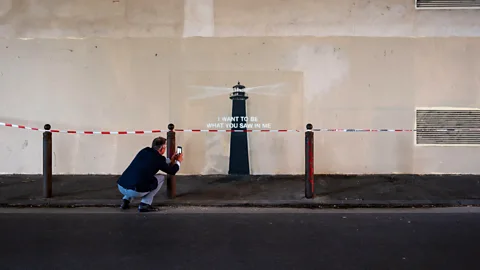Five works that reveal the philosophy of Banksy
 Photo of Lighthouse, 2025/ Alamy
Photo of Lighthouse, 2025/ AlamyBanksy's new mural in Marseille is not the first image he has connected to the history of ideas. From Plato to Foucault, a Banksy expert reveals the philosophy behind these popular artworks.
Which is the real you, the person you are now or the one you are capable of becoming? It's a heady question, to be sure, and not one you would expect to be confronted with while strolling down a street in Marseille in the waning days of May. Yet it's precisely the existential dilemma that Banksy, who once asserted "being yourself is overrated" – has surreptitiously installed in a cloistered stretch of the quiet Rue Félix Fregier, the site of a new work – the latest installment in the elusive artist's decades-long career as a provocative philosophical prankster.
For more than 30 years, Banksy has spiked many of his most iconic works – from his girl reaching hopelessly for a heart-shaped balloon to his masked rioter hurling a bouquet of flowers – with barbed allusions to Old Masters, from Michelangelo to Monet, Vermeer to Van Gogh. But there's more. Beneath his stealthy stencils lies a deep and deliberate engagement with the history of ideas as well, from classical Stoicism to postmodern deconstructionism.
On 29 May, Banksy posted on Instagram a photo of his first new piece in more than five months, piquing the internet's interest by withholding its precise location. Discovered shortly thereafter in the major port city in southern , Marseille, the mural is, at first glance, deceptively simple: a tall silhouette of a lighthouse spray-painted on to a blank beige urban wall; a rusting street bollard positioned nearby; and a painted shadow stretching across the pavement, ing the real-world object to its augmented, if two-dimensional, echo. Stencilled across the black lighthouse are the words: "I want to be what you saw in me."
Anyone keen to find a source for the ideas that inform Banksy's new work needs merely to flip open any history of philosophy to Plato's seminal allegory of the cave (from the Fourth-Century BC treatise The Republic), then flip the ancient metaphor on its head. In Plato's parable, prisoners chained inside a cave mistake shadows on the wall for reality, unaware of the truer forms that cast them outside. But here, Banksy, being Banksy, baits us by switching the set-up, reversing the relationship between essence and shadow. In Banksy's mural, the drab bollard casts not a diminished imitation of itself, but something far grander – a lighthouse, a symbol of illumination and guidance. Here, it's the silhouette, not reality, that's true.
Banksy's inversion urges us to ask where reality really resides: in what is, or in what might be? His poignant phrase – "I want to be what you saw in me" – is alluringly elastic. Is this the bollard dreaming of being more than it appears? Or the shadow wishing to become light? Or is it all of us – Banksy included – struggling to live up to the better versions imagined by those who believe in us? The answer is surely yes to all of the above. And it's a yes too to the question: 'is this new work a lamp capable of shining light on further levels of meaning in Banksy">window._taboola = window._taboola || []; _taboola.push({ mode: 'alternating-thumbnails-a', container: 'taboola-below-article', placement: 'Below Article', target_type: 'mix' });
